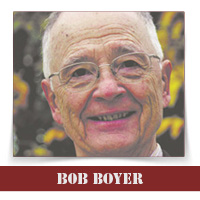
By: Bob Boyer
Mindanao for me remains a mixture of romantic mystery and danger. While I have spent considerable time in the north, Luzon, and in the middle, the Visayas, I have yet to visit the south, Mindanao. I regret that, a regret is likely to continue for some time because of President Duterte’s declaration of Martial Law there. Still, I can at least reflect on my early second-hand acquaintance with M indanao and on reports from a couple of first-hand sources. On my five v isits to the Philippines, I regularly read about Mindanao in the local papers. So I’ve decided to revisit what I learned, and then wrote about, Mindanao in Sundays in Manila in 2010 to help me understand why Mindanao co ntinues to fascinate me.
“To the south of the Visayas lies Mindanao. About one-third of the population of Mindanao is Muslim, the other two-thirds being, like the rest of the country, mostly Roman Catholic. Located at the opposite end of the archipelago from the capital, Manila, and also boasting much rugged terrain of mountains and jungles, Mindanao sheltered its inhabitants from outside interference. Thus a sizable number remained Muslim rather than accept Spanish Christianity. Likewise the Americans and the Japanese never completely managed to control the island during their respective turns as colonizers or occupiers.” (p. 15)
“Relations between parts of Mindanao and the government in Manila remain uneasy, at times breaking down completely, which is partly why travelers like me have been cautioned in recent years by the US State Department to avoid visiting most areas other than around Davao, the capital city. Conditions, including geography, government neglect, and sympathy for fellow Muslims, have favored the growth of Muslim activists, some of whom have ties with terrorist groups. The government and the Armed Forced of the Philippines, assisted by the US Special Forces, have begun to lessen the influence of such terrorist groups through a combination of military and humanitarian aid to the local people.” (p. 15)
“The area of the densest Muslim population has, as a result of years of struggle by the Muslim majorities in those regions, gained a measure of independence and the designation of “Autonomous Regi on in Muslim Mindanao” (ARMM). Although ARMM has a measure of self-governance, it remains largely under the rule of Manila. Geographically ARMM occupies a relatively small area located in the far west-c entral section of Mindanao. Part of ARMM is a chain of islands off its west coast that dot their way practically to Indonesia’s Borneo. Indonesia is a kindred Muslim state.” (p. 15)
“Because I have never visited there, Mindanao has the romantic aura of the unknown for me. Having flown and sailed to dif ferent parts of the Visayas where I have gotten my feet on the ground, I have at least a feel for the region and a sense of how these midlands differ from Luzon. I do not have the same sense of personal acquaintance as yet for Mindanao.” (p. 16)
I still hope to visit Mindanao. In the meantime a couple of friends have shared their personal experiences with me. Two summers ago I spent a two-hour lunch with a friend who was a Peace Corps volunteer in the Philippines in 1961-1962. Jerry loved it, even being in a Nipon hut during a storm that approached typhoon-level winds. He spe nt all of his second year there travelling around the different parts of Mindanao, helping to establish additional Peace Corps sites. He laughed as he described his army surplus jeep bouncing over the dirt roads. I wrote about his adventures in the August 2015 issue of this magazine. He wrote to me after his 2016 Peace Corps reunion in the Philippines, which he thoroughly enjoyed.
My Wisconsin nephew Ted has a Filipino girlfriend, his unofficial fiancé, in Cagayan de Oro, in North Central Mindanao (Jerry would recognize the still-bumpy roads), whom he visits as often as he can. They hope to marry, but she has to obtain an annulment—a tough assignment since divorce is illegal. Once the annulment is official and th ey marry, they will live in the U.S., but Ted has grown to appreciate Mindanao, particularly the people, whom he finds friendly and happy. I wrote here about his most recent visit (“Filipinos Through Filipino Eyes,” Ap. 2017).
Contact Bob Boyer at Robert.boyer@snc.edu or <anamericaninmanila. com>.
 VIA Times – August 2017 Issue Vital News, Vibrant VIews for Asian Americans in Chicago & Midwest
VIA Times – August 2017 Issue Vital News, Vibrant VIews for Asian Americans in Chicago & Midwest

